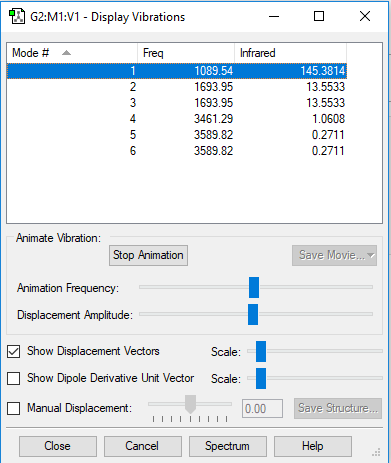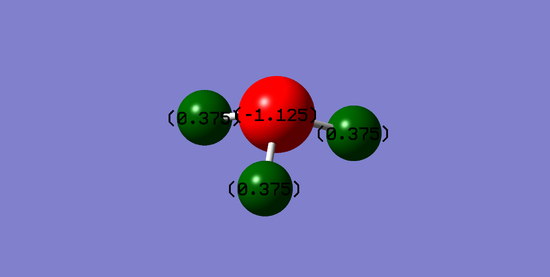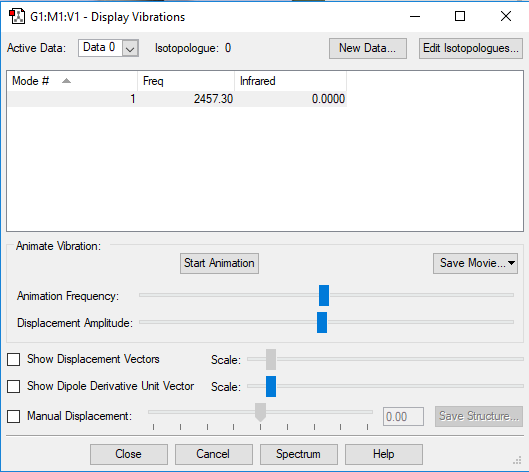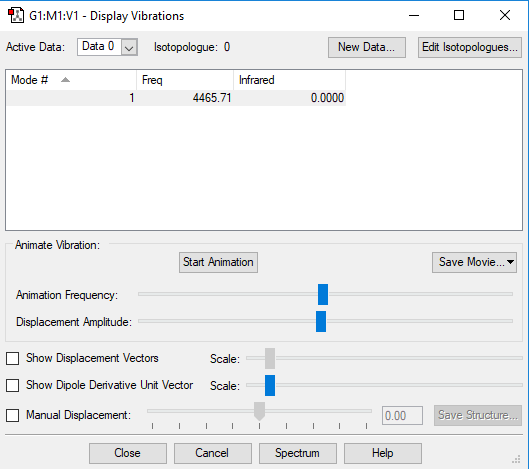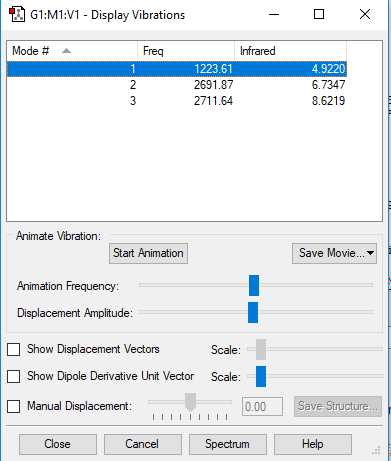Rep:Mod:01485762
NH3 molecule
"Item" table of NH3
Item Value Threshold Converged?
Maximum Force 0.000004 0.000450 YES
RMS Force 0.000004 0.000300 YES
Maximum Displacement 0.000072 0.001800 YES
RMS Displacement 0.000035 0.001200 YES
Key Information About the Optimised NH3
- molecule name: NH3 (Ammonia)
- calculation method: RB3LYP
- basis set: 6-31G(d,p)
- final energy E(RB3LYP) in atomic units (au): -56.557769 a.u.
- the point group: C3V
- RMS gradient: 0.00000485 a.u.
- the optimised N-H bond distance: 1.01798 A
- the optimised H-N-H bond angle: 105.741°
Jmol dynamic image of NH3
test molecule |
Linkage to a "log" file
The optimisation file is linked to here
Vibrations
| wavenumber(cm-1) | 1090 | 1694 | 1694 | 3461 | 3590 | 3590 | |
|---|---|---|---|---|---|---|---|
| symmetry | A1 | E | E | A1 | E | E | |
| intensity arbitrary units | 145 | 14 | 14 | 1 | 0 | 0 |
- how many modes do you expect from the 3N-6 rule?
3*4-6=6 modes
- which modes are degenerate (ie have the same energy)?
Modes 2 and 3 have the same energy and modes 5 and 6 have the same energy.
- which modes are "bending" vibrations and which are "bond stretch" vibrations?
"Bending" vibrations: Modes 1, 2 and 3. "Bond stretch" vibrations: Modes 4, 5 and 6.
- which mode is highly symmetric?
Mode 4.
- one mode is known as the "umbrella" mode, which one is this?
Mode 1.
- how many bands would you expect to see in an experimental spectrum of gaseous ammonia?
Two. One at 1090 cm-1 and the other at 1694 cm-1.
Charges
Nitrogen should carry a negative charge as it is more electronegative than hydrogen, attracting more electrons (negative charges) around it. Hydrogen should carry a positive charge as it is less electronegative, which indicates its weak ability to attract electrons.
N2 and H2 molecules
"Item" table of N2
Item Value Threshold Converged? Maximum Force 0.000011 0.000450 YES RMS Force 0.000011 0.000300 YES Maximum Displacement 0.000004 0.001800 YES RMS Displacement 0.000005 0.001200 YES
Key Information About the Optimised N2
- molecule name: N2 (Nitrogen)
- calculation method: RB3LYP
- basis set: 6-31G(d,p)
- final energy E(RB3LYP) in atomic units (au): -109.524129a.u.
- the point group: D*H (D∞h)
- RMS gradient: 0.00000652 a.u.
- the optimised N-N bond distance: 1.10550 A
Jmol dynamic image of N2
test molecule |
Linkage to a "log"
The optimisation file is linked to here
Vibrations of N2
| wavenumber(cm-1) | 2457 |
|---|---|
| intensity arbitrary units | 0 |
Charges of N2
"Item" table of H2
Item Value Threshold Converged? Maximum Force 0.000002 0.000450 YES RMS Force 0.000002 0.000300 YES Maximum Displacement 0.000002 0.001800 YES RMS Displacement 0.000003 0.001200 YES
Key Information About the Optimised H2
- molecule name: H2 (Hydrogen)
- calculation method: RB3LYP
- basis set: 6-31G(d,p)
- final energy E(RB3LYP) in atomic units (au): -1.178539a.u.
- the point group: D*H (D∞h)
- RMS gradient: 0.00000106 a.u.
- the optimised H-H bond distance: 0.74279 A
Jmol dynamic image of H2
test molecule |
Linkage to a "log" file
The optimisation file is linked to here
Vibrations of H2
| wavenumber(cm-1) | 4466 |
|---|---|
| intensity arbitrary units | 0 |
Charges of H2
Metal Complex
The complex containing H2 is (Dihydrogen)-(1,2-ethanediamine-N,N'-dimethyl-N,N'-bis(2-benzenethiolato))-(tri-isopropylphosphine)-ruthenium(BIDQUB). The H-H bond length in the complex is 0.91(5) A. The detailed information about the complex can be found in CSD[BIDQUB].
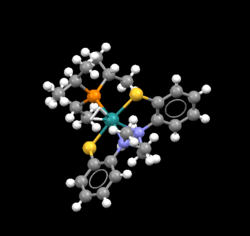
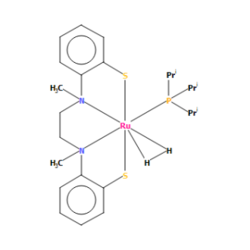
The bond length of H-H bond in crystal structure is longer than that of computational data. The reason being in crystal structure, H-H is in a different structure in which each H is connected to two other atoms, thus weakening the attraction between two hydrogens, decreasing the bond strength which gives rise to longer bong length. Moreover, the central metal tends to attract hydrogen atoms towards it due to high electron density of the metal ion, resulting in stronger bond strength between hydrogen and metal and weakening the bond strength between hydrogen atoms, thus longer bond distsance in the crystal structure. For the computational structure, only two atoms are present and there are no external forces of attraction or repulsion to affect the bond length. Apart from that, hydrogen is in gaseous phase under standard states; in crystal metal complex, the hydrogen is mainly in solid states. Therefore, the bond distance may also be affected by interaction of surrounding molecules(atoms). The more particles, the higher probability of interactions.
Haber-Bosch Process
E(NH3)=-56.557769 a.u
2*E(NH3)=-113.115538 a.u
E(N2)=-109.524129a.u
E(H2)=-1.178539 a.u
3*E(H2)=-3.535618 a.u
ΔE=2*E(NH3)-[E(N2)+3*E(H2)]=-0.055791 a.u
=-146.5kJ/mol
Therefore, the product ammonia is more stable than the reactants (nitrogen and hydrogen), as it is lower in energy.
SH2 molecule (choice of molecules)
"Item" table of SH2
Item Value Threshold Converged? Maximum Force 0.000175 0.000450 YES RMS Force 0.000145 0.000300 YES Maximum Displacement 0.000386 0.001800 YES RMS Displacement 0.000386 0.001200 YES
Key Information About the Optimised SH2
- molecule name: SH2 (Hydrogen sulfide)
- calculation method: RB3LYP
- basis set: 6-31G(d,p)
- final energy E(RB3LYP) in atomic units (au): -399.391624 a.u.
- the point group: C2V
- RMS gradient: 0.00012068 a.u.
- the optimised S-H bond distance: 1.34737 A
- the optimised H-S-H bond angle: 92.681°
Jmol dynamic image of SH2
test molecule |
Linkage to a "log" file
The optimisation file is linked to here
Vibrations
| wavenumber(cm-1) | 1224 | 2692 | 2712 | |
|---|---|---|---|---|
| symmetry | A1 | A1 | B2 | |
| intensity arbitrary units | 5 | 7 | 9 |
Additional information
Hydrogen sulfide is highly unstable under high pressure ( 200GPa) towards vibrations of H-atoms. When coupling to H-vibrations, the system SH2 is in is likely to undergo transitions. The literature value shows SH2 has three vibration modes at 2615, 1183 and 2626 cm−1.
Charges
Sulfur is negative in charge value whereas hydrogen is positive in charge value. Sulfur is more electronegative.
Additional information
SH2 has the formal charge of 0 in which S has oxidation state of -2 and H of +1. Therefore, S has charge of -2e (e=1.60*10-19) and each H has charge of e.
MOs
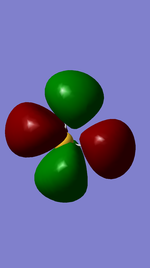
This is the LUMO (lowest unoccupied molecular orbital) of SH2 molecule. It is antibonding and is unoccupied, with energy of 0.02126 a.u. The 3p(y) orbital in sulfur is involved in the structure. When bonding, it is the first orbital to accept electrons.

This is the HOMO (highest occupied molecular orbital) of SH2. It is bonding and is occupied by two electrons.The 3p(x) orbital in sulfur is involved in the structure. During reactions, it is the first orbital to lose electrons, resulting in breaking bonds.

The molecular orbital is formed by the 2p(y) orbital and is occupied. It is bonding and has an energy of -5.90552 a.u. It is the 5th lowest in energy, which is less stable than 2p(x) and 2p(z) orbitals of sulfur.

The molecule orbital is formed by 2p(z) orbital in sulfur and is occupied by two electrons. It is the 3rd lowest in energy (-5.91588 a.u)and is bonding.

The bonding molecule orbital is formed by 2p(x) orbital in sulfur and is occupied. It is higher in energy than 2p(z) but lower in energy than 2p(y), with energy of -5.91268 a.u.
Comparisons to literature value
1.The equilibrium bond length for ammonia is predicted to be 1.040 Å , which is longer than the optimised N-H bond distance (1.01798 A) in this case.
2.The equilibrium bond length for hydrogen is 0.720 Å in literature, which is shorter than the optimised N-H bond distance (0.74279 A) in this case.
Referencing
1.Equilibrium bond length of ammonia. </https://aip.scitation.org/doi/10.1063/1.469458> 2.Equilibrium bond length of hydrogen. <https://www.researchgate.net/publication/299208301_The_bond_length_of_a_hydrogen_molecule_under_confinement_in_a_single_wall_carbon_nanotube> 3. Additional informations about vibrations of SH2. <https://arxiv.org/abs/1511.02769> 4. Literature values for the vibrational modes of SH2. <https://www.cfa.harvard.edu/hitran/vibrational.html>
Marking
Note: All grades and comments are provisional and subjecct to change until your grades are officially returned via blackboard. Please do not contact anyone about anything to do with the marking of this lab until you have recieved your grade from blackboard.
Wiki structure and presentation 0.5/1
Is your wiki page clear and easy to follow, with consistent formatting?
YES
Do you effectively use tables, figures and subheadings to communicate your work?
YES - however all your jmols are labelled "target molecule" which is not informative at all
NH3 1/1
Have you completed the calculation and given a link to the file?
YES
Have you included summary and item tables in your wiki?
YES
Have you included a 3d jmol file or an image of the finished structure?
YES
Have you included the bond lengths and angles asked for?
YES
Have you included the “display vibrations” table?
YES
Have you added a table to your wiki listing the wavenumber and intensity of each vibration?
YES
Did you do the optional extra of adding images of the vibrations?
YES
Have you included answers to the questions about vibrations and charges in the lab script?
YES - you answered all questions correctly, well done!
N2 and H2 0.5/0.5
Have you completed the calculations and included all relevant information? (summary, item table, structural information, jmol image, vibrations and charges)
YES, you could have explained that the charges are 0 as the electronegativities are equal.
Crystal structure comparison 0.5/0.5
Have you included a link to a structure from the CCDC that includes a coordinated N2 or H2 molecule?
YES
Have you compared your optimised bond distance to the crystal structure bond distance?
YES
Haber-Bosch reaction energy calculation 1/1
Have you correctly calculated the energies asked for? ΔE=2*E(NH3)-[E(N2)+3*E(H2)]
YES
Have you reported your answers to the correct number of decimal places?
YES
Do your energies have the correct +/- sign?
YES
Have you answered the question, Identify which is more stable the gaseous reactants or the ammonia product?
YES
Your choice of small molecule 4/5
Have you completed the calculation and included all relevant information?
YES
Have you added information about MOs and charges on atoms?
YES - however there are some mistakes on the description of the MOs. From the second to the last displayed MO all are non-bonding MOs since there are no interactions between the p Orbital and a s orbital on the Hs. The LUMO was identified correctly but the contribution of the 2 orbitals on the Hs were not mentioned.
Independence 1/1
If you have finished everything else and have spare time in the lab you could: Check one of your results against the literature, or
YES
Do an extra calculation on another small molecule, or Do some deeper analysis on your results so far

